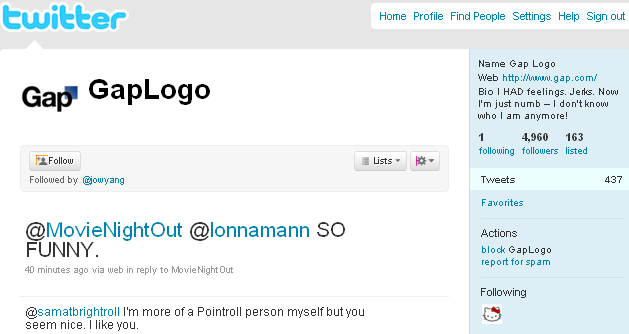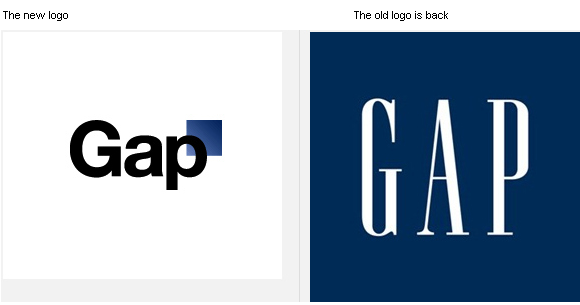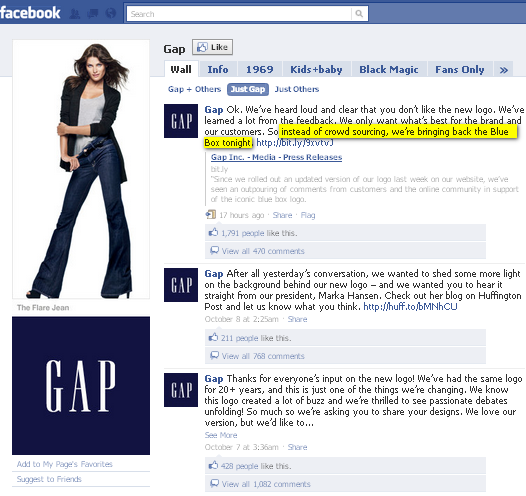2010-10-19 – Update – A survey with GAP customers revealed that just about 20% were even aware that the company had updated its logo. This raises again the question we asked during the Nestlé vs. Greenpeace fiasco (read under point 5):
- Is the online reaction to a design change, campaign led by an activist group, etc. really representative of your target audience?
I don’t think this is necessarily the case, as both, the Gap logo (this story) and the Nestlé KitKat example illustrate.
Watch the video further below
Social media monitoring DOs and DON’Ts: social media marketing, social media metrics, social media monitoring tools, benchmark test, Twitter monitoring, luxury branding, customer relationship management and other happenings we came across while surfing the internet, blogging and posting on Facebook, Identi.ca, Google Buzz, or Twitter.
You can find previous posts in our series on social media marketing and social media monitoring here:
- 1. Social media definition: 3 essentials
2. Social media marketing definition: 2 essentials
3. Why PR fails with social media
4. Corporate blog definition: 4 essentials
5. 4 ways to foster dialogue with corporate blogs
6. 4 strategies to leverage usability tests
In this post, we share some interesting things we learned about consumer behaviors online regarding the GAP, customer relationship management in the social media space and how to fumble through a flop and come out a winner – things you should know about.
- This week
One reason why high-fashion brands have been slow to embrace social media could be that they are afraid to lose control over their image. A social media dialogue with consumers allows them to say anything they like, as illustrated by a recent incident with the GAP brand.
The company decided to change its logo (see below); the new one was created with Laird & Partners, New York. Unfortunately for the GAP, not many seemed to like it and the company felt forced to change course.
As the Facebook wall shows, GAP followers (are they customers as well?) who did not like it were very vocal about it.
In fact, a fake Twitter account garnered a few thousand followers, while some people created logo generators, helping things go viral.

The company then invited people to send in their own logo ideas, but this provoked more criticism, this time about crowdscourcing, with some stating that the GAP Facebook page was putting designers out of work. Another blow to the company’s image.
- Donna Marie: “Asking designers to re-design your logo through this spec work stunt is completely appalling and beyond unethical! You are blatantly DEVALUING an already devalued profession. I am boycotting Gap and all it’s affiliates from here on out. You should be truly ashamed of yourself. And btw, since I am re-designing your logo for next to nothing, would you mind giving me about ten thousands pairs of jeans that are especially designed just for me for free? After all, designing jeans is EASY and FUN, right? So it should be done for next to nothing. Thanks.”
In a statement, North American GAP president Marka Hansen explains:
- We’ve learned a lot in this process. And we are clear that we did not go about this in the right way. We recognize that we missed the opportunity to engage with the online community. This wasn’t the right project at the right time for crowd sourcing.
Reading the press release suggests that the GAP was not expecting so much, if any, negative feedback.
Nevertheless, the question remains whether the flurry of social media feedback the company got will negatively affect its bottom line or, as we suspect, the additional global attention will translate into increased profits.
More resources
- Nestlé, KitKat and Greenpeace
Case studies – successes, flops and disasters
4 roads to success? Microsoft, NBC, Toyota and Swiss PostBus
Advertising firsts in social media (see Friday, Swiss Air Lines)
Hollyoaks excels as Google stumbles
Why UBS flopped on YouTube (see Monday) and United is still breaking guitars (see Sunday)
Bottom line and take-aways
In short, GAP reverted to the original logo after the social media backlash. What lessons can be learned from this debacle?
- 1. The outcry on Twitter and Facebook matters little, if at all: Social media helps negative news spread increasingly quickly (e.g., child sweatshop shame threatening GAP’s ethical image – October 2007). However, as the Nestlé versus Greenpeace case illustrates, things quickly die down and get smoothed over. Social media pundits have a short attention span and soon move on to new matters.
2. Turning a downside event into an upside and improving brand loyalty: If the GAP had known this might happen (president’s statement above suggests this was unexpected), this case would illustrate that taking a risk by being transparent on social media can create backlash. However, the social media attention, print copy and TV news coverage the GAP garnered through this mishap are likely worth the trouble.
3. PR pundits may not apply: This case shows that a corporate communication approach via press releases fails to create the level of trust the company wants when engaging with clients on Facebook or Twitter. Like many of us, the GAP is still working on getting a handle on the engagement requirement to fully succeed in the social media space.
What is your take? How do you see these issues? Please let us know in the comments!
Article source: ComMetrics weekle review: Do mind the GAP
Lessons 4 – 6 are presented in the 3-minute video below – The ComMetrics Online Intel Show.



Pingback: Urs E. Gattiker
Pingback: CyTRAP
Pingback: Askoli -rise with us
Pingback: Community Strategies
Pingback: Chris Isaac
Pingback: Craig Weiss
Pingback: OpenSesame
Pingback: World Economic Forum
Pingback: Jens Rittgerodt
Pingback: Urs E. Gattiker
Pingback: Frank Tenorio
Pingback: 2011 trends: Risk management and social media ROI » social media monitoring, social media marketing, Twitter monitoring, Facebook strategy, social media ROI, customer engagement, customer relationship management, » Helping you benchmark smarter to incre
Pingback: Christmas and luxury brands » social media monitoring, social media marketing, luxury brand, Twitter monitoring, Facebook strategy, social media ROI, customer engagement, customer relationship management, » Helping you benchmark smarter to increase ROI